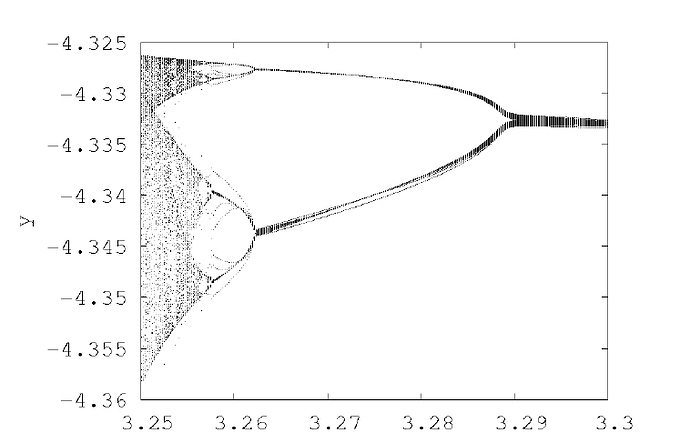Hi All,
Do you have any idea about how to plot a bifurcation diagram in 3D nonlinear differential equations ?
I mean that which computational method do i need to use to plot a bifurcation diagram ?
Could it be such that the first is to use the newton-raphson method with gaussian elimination to find the roots of equations , then the second is to draw a bifurcation diagram which consists of a control parameter versus one of the roots which found with the method ?
I tried to draw the diagram with the method i mentioned above. As a control parameter varies, i found the roots, then i plotted the diagram one of roots versus a control parameter. However, i didn’t get it.
My script is as in the following ;
//The Hindmarsh_Rose Neuronal Model '84
//Firstly, Finds the roots of the equations via Newton's Raphson and Gaussian-Elimination
//Then, as a control parameter varies, draw a bifurcation diagram which consists of a control parameter versus one of the roots
#include <iostream>
#include <tuple>
#include <TMath.h>
#include <TH2D.h>
#include <TCanvas.h>
#include <fstream>
Int_t size = 3;
Int_t n =3;
using namespace std;
Double_t f1(Double_t &x, Double_t &y, Double_t &z,Double_t &u) {
Double_t f1;
f1 = y+3.0*pow(x,2)-pow(x,3)-z+u;
return f1;
}
Double_t f2(Double_t &x, Double_t &y) {
Double_t f2;
f2 = 1.0-5.0*pow(x,2)-y;
return f2;
}
Double_t f3(Double_t &x, Double_t &z) {
Double_t f3;
f3 = 0.001*(4.0*(x-(-1.6180))-z);
return f3;
}
tuple <Double_t, Double_t, Double_t, Double_t, Double_t, Double_t, Double_t, Double_t, Double_t> J(Double_t &x, Double_t &y, Double_t &z) {
Double_t j1[3] = {(-3.0*pow(x,2)+6.0*x),(1.0),(-1.0)};
Double_t j2[3] = {(-10.0*x),(-1.0),(0)};
Double_t j3[3] = {(0.004),(0.0),(-0.001)};
return make_tuple(j1[0],j1[1],j1[2],j2[0],j2[1],j2[2],j3[0],j3[1],j3[2]);
}
tuple <Double_t, Double_t, Double_t> NaiveGaussianElimination(Double_t a[3][3], Double_t b[3]) {
Double_t factor,sum;
Int_t k,i,j;
Double_t x[3];
for(k=0; k<n-1; k++) {
for(i=k+1; i<n; i++) {
factor = a[i][k]/a[k][k];
for(j=k+1; j<n; j++) {
a[i][j] = a[i][j] - factor * a[k][j];
}
b[i] = b[i] - factor * b[k];
}
}
for(i=2; i<n; i++) {
x[i] = b[i] / a[i][i];
}
for(i=n-1; i>-1; i--) {
sum = b[i];
for(j=i+1; j<=n; j++) {
sum = sum - a[i][j] * x[j];
}
x[i] = sum / a[i][i];
}
return make_tuple(x[0],x[1],x[2]);
}
void NewtonsRaphsonForNonlinear3D() {
TH2D *h1 = new TH2D("h1","Bifurcation Diagram",10000,2,3,10000,-3,-4);
Int_t N=5;
Double_t j00,j01,j02,j10,j11,j12,j20,j21,j22;
Double_t a[3][3],b[3],c[3];
Double_t x,y,z,p,r,s,u,f,g,h;
Double_t time;
x = 0.1;
y = 0.1;
z = -0.1;
u = 1.0;
time = 0.0004;
while(u<=5.0) {
x = 0.1;
y = 0.1;
z = -0.1;
for(Int_t i=0; i<N; i++) {
//Computing J(x(0))y(0) = −F(x(0))
b[0] = f1(x,y,z,u);
b[1] = f2(x,y);
b[2] = f3(x,z);
tie(a[0][0],a[0][1],a[0][2],a[1][0],a[1][1],a[1][2],a[2][0],a[2][1],a[2][2])=J(x,y,z);
for(Int_t j=0; j<3; j++) {
c[j] = (-1.0)*b[j];
}
tie(p,r,s)=NaiveGaussianElimination(a,c);
f=x;
g=y;
h=z;
x += p;
y += r;
z += s;
/* cout<<f-x<<"\t";
cout<<g-y<<"\t";
cout<<h-z<<"\t";
*/
cout<<setprecision(8);
cout<<setw(20);
// cout<<x<<setw(20)<<y<<setw(20)<<z<<setw(20)<<endl;
}
cout<<x<<setw(20)<<y<<setw(20)<<z<<setw(20)<<endl;
u += time;
h1->Fill(u,y);
}
h1->Draw();
}
Also, i tried to draw the diagram and solve the equations with Runge-Kutta method as the control parameter varies. But again, i didn’t achieve it!
This script is as in the following;
include <iostream>
#include <TGraph.h>
#include <TCanvas.h>
#include <fstream>
#include <TMath.h>
using namespace std;
void HR_Bifurcation_R() {
TCanvas *c1 = new TCanvas("c1","Hindmarsh-Rose Model",800,600);
TH2D *h1 = new TH2D("h1","r vs y(t)",10,0,0.005,10,-2,2);
Int_t N = 100;
Double_t a,b,c,d,s,x0,u;
Double_t x,y,z,t,r;
Double_t k1,k2,k3,k4,l1,l2,l3,l4,m1,m2,m3,m4;
Double_t h,p;
//initial conditions \
a = 1.0;
b = 3.0;
c = 1.0;
d = 5.0;
x0 = -1.6180;
u = 3.25;
s = 4.0;
t = 0.0;
r = 0.0;
h = 0.001;
p = 0.00005;
Int_t i;
while(r<=0.005) {
x = 0.1;
y = 0.1;
z = 0.1;
for (i=0; i<N; i++) {
//Runge-Kutta Method
k1 = ((-a*(TMath::Power(x,3)))+b*(TMath::Power(x,2))+y-z+u);
l1 = (c-d*(TMath::Power(x,2))-y);
m1 = (r*(s*(x-x0)-z));
k2 = ((-a*(TMath::Power((x+0.5*k1*h),3)))+b*(TMath::Power((x+0.5*k1*h),2))+(y+0.5*l1*h)-(z+0.5*m1*h)+u);
l2 = (c-d*(TMath::Power((x+0.5*k1*h),2))-(y+0.5*l1*h));
m2 = (r*(s*((x+0.5*k1*h)-x0)-(z+0.5*m1*h)));
k3 = ((-a*(TMath::Power((x+0.5*k2*h),3)))+b*(TMath::Power((x+0.5*k2*h),2))+(y+0.5*l2*h)-(z+0.5*m2*h)+u);
l3 = (c-d*(TMath::Power((x+0.5*k2*h),2))-(y+0.5*l2*h));
m3 = (r*(s*((x+0.5*k2*h)-x0)-(z+0.5*m2*h)));
k4 = ((-a*(TMath::Power((x+k3*h),3)))+b*(TMath::Power((x+k3*h),2))+(y+l3*h)-(z+m3*h)+u);
l4 = (c-d*(TMath::Power((x+k3*h),2))-(y+l3*h));
m4 = (r*(s*((x+k3*h)-x0)-(z+m3*h)));
x = x + ((k1+2*(k2+k3)+k4)/6)*h;
y = y + ((l1+2*(l2+l3)+l4)/6)*h;
z = z + ((m1+2*(m2+m3)+m4)/6)*h;
t += h;
cout<<x<<"\t"<<y<<"\t"<<z<<"\t"<<t<<"\t"<<r<<endl;
h1->Fill(r,y);
}
r += p;
}
c1->cd();
h1->SetTitle("Bifurcation Diagram of HR Model");
h1->GetXaxis()->SetTitle("r");
h1->GetYaxis()->SetTitle("y(t) - The exchange of Ions");
h1->Draw();
}
Thanks a lot,
Cheers,
Ersel
